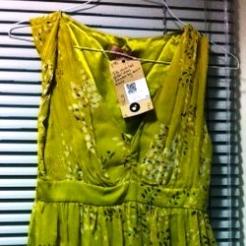Oxfam is extending its use of new technology which allows shoppers to view the history of items, after an initial trial increased turnover in a Manchester shop by 41 per cent.
The technology has been devised by academics at University College London (UCL), and uses QR code technology to create “a social network for objects”.
Oxfam will now introduce the technology into 20 more of its shops, allowing customers to scan the codes with their mobile phones in order to access information about items such as past geographical locations, stories from previous owners and video clips.
Initial examples include a dress donated by singer Annie Lennox (pictured) which is linked to a video where she talks about how she wore it to Nelson Mandela’s 90th birthday party, and a stripy jumper which includes a story from a previous owner about how she wore it the first time she met her ex-boyfriend.
A spokeswoman for Oxfam said: “Promoting sustainability and encouraging consumers to look beyond disposable fashion and love items for longer is an important part of what Oxfam shops bring to the high street.
“The stories behind vintage and second-hand garments are part of their desirability and we find that items with an interesting history instantly have added value for our customers.”
Speaking at the British Science Festival earlier this week, Dr Andy Hudson-Smith, director of the Centre for Advanced Spatial Analysis at UCL, said: “In 20 years time it may well be possible to enter a shop where each object is able to offer up its own history - what sort of person owned the object before, where they got it from and what memories are associated with it.”
Oxfam shops help to launch 'social network for objects'
Oxfam is extending its use of new technology which allows shoppers to view the history of items, after an initial trial increased turnover in a Manchester shop by 41 per cent.









